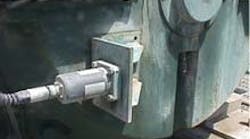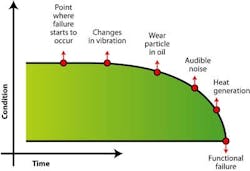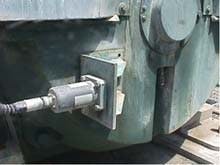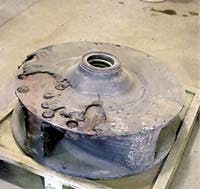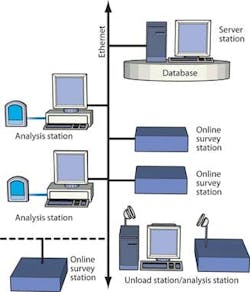By Sheetalnath Mahalungkar and Mike Ingram
In the cement industry, keeping equipment running is essential. Lost production due to equipment failure is not acceptable, especially during times of peak demand. Maintenance is expensive, but it is not an uncontrollable cost. As the industry has evolved with better and more efficient technology, scheduled or preventive maintenance (PM) has replaced reactive maintenance, resulting in better equipment availability. However, even with scheduled preventive maintenance, unpredictable failures can occur.
The industry’s approach is now shifting from scheduled maintenance to predictive maintenance (PdM), where new technology is used to constantly observe equipment conditions and predict potential failures. The source of an equipment abnormality is identified and corrected before an incident occurs.
In this reliability-centered maintenance (RCM) approach, efforts are focused on providing advance warning of signs of trouble to prevent sudden failure. Predictive maintenance is the current trend in the manufacturing industry. Condition monitoring through vibration and oil analysis is the latest technique for achieving higher equipment availability.
Early warning system
Figure 1. Rotating-machinery failures typically follow a pattern where vibration increases well before equipment breaks down.
Kiln folks
Switzerland-based Holcim Ltd. is one of the world’s leading suppliers of cement and related construction materials, including mineral components, aggregates and ready-mix. It operates in more than 70 countries. Holcim (US) Inc., a wholly owned subsidiary, is one of the country’s largest makers of cement and mineral components. It includes 14 manufacturing facilities, 11 of which are cement plants.
Developments in technology, increases in product quality, and demand for product have driven the need for new methods to run equipment more reliably and at lower cost. The company is implementing many technologies to standardize processes.
The company has been proactive about equipment reliability and has been investing in the latest technologies available to monitor and predict possible equipment failures. It has a well-developed preventive maintenance program and has been moving toward condition-based maintenance in the past decade.
RCM is the center of maintenance activity at Holcim’s Portland cement manufacturing plant in
A kiln this size, if it is shut down due to equipment failure, can incur costs totaling thousands of dollars per hour in lost clinker production. At the same time, it strains the supply chain due to reduced cement production and inventory. This is the lost cost in production.
There is also additional maintenance cost due to sudden failure of equipment and consequential unplanned expenditures of material and overtime labor. The cost for damaged equipment has to be considered as well.
In an effort to avoid those costs, the plant has installed online vibration-monitoring systems on all critical equipment. The online transducers are connected to the centralized control room through PLCs. The equipment has settings for alarm and shutdown in case of excessive vibration.
The
Predictive predicament
Holcim had been effectively implementing PM programs for two decades, but a few failures in bearings and gears went undetected. The solution to this issue was answered in the new condition-monitoring techniques made available by the development in technology. Vibration analysis, oil analysis and infrared thermography can predict the failure of a bearing or a problem with a drive well in advance of unplanned equipment shutdown.
Maintenance comprises about 20% of total production costs at the Florence Portland plant, so preventing even one failure can result in significant savings, increased production and improved earnings. Vibration data collection and analysis is a very useful part of the condition-monitoring program. Used efficiently and supported by condition-monitoring tools like oil analysis, thermography and root cause analysis, it can prevent significant losses to the company.
Vibration analysis is extremely effective in detecting a range of problems in rotating machinery, including imbalance, mechanical looseness, misalignment, gear defects and motor problems. Vibration-related failures behave characteristically (Figure 1).
Correct detector
Figure 2. A seismic self-generating velocity pickup responds effectively to the machinery defect frequencies expected from cement plant equipment.
Several Holcim (US) plants were using various types of condition-monitoring equipment to predict equipment health. The Florence Portland plant was one of the first to implement a full-fledged, two-phase condition-monitoring program. The motors there are being monitored by vibration and temperature sensors that shut the equipment down before any catastrophic failure occurs.
This surveillance system, though sufficient to prevent permanent damage to the equipment, cannot determine the cause of high vibration or temperature levels. This prompted the search for an advanced system to monitor equipment health through analysis.
A survey was conducted to identify vendors that could supply the most suitable and cost-effective equipment for the plant’s needs. The factors used to select the instrument supplier included available technology, service and cost. The chosen program is in the first phase of implementation and is already showing savings. It is being successfully implemented at the Florence Portland plant and has helped improve availability of equipment. This practice is being replicated at other Holcim plants in the
A solid foundation
The amplitude of vibration in a machine is a measure of how much motion is occurring and is proportional to the force acting on the bearings. Amplitude readings can be used to trigger the alarm for high vibration and shut the equipment down if the vibrations exceed safe limits.
In practice, a two-wire transmitter converts the analog signal to a 4-20 mA signal and transfers it to a PLC. The system performs failure protection: It protects the equipment from permanent failure, but is not capable of predicting the cause of high-vibration amplitudes.
Vibration frequency is the rate at which motion is occurring. More importantly, based on experience, frequency tells us what force is acting on the system to cause the vibration. For example, unbalance always occurs at a frequency equal to the running speed of the machine (1 x RPM). Mechanical vibration frequencies are of two types: synchronous (multiple of rotation speed) and asynchronous (not a multiple of rotational speed).
How a vibration-monitoring program is implemented (data-collection method and type of monitoring) is highly influenced by the size of the plant and the amount of equipment (data collection points). Setting up data collection points and routes is very important and can be a cumbersome job. Along with these issues, the criticality of the equipment to be monitored, rate of failure of different equipment, and the time to failure from the point when high vibration starts all influence the selection of permanently installed online sensors.
A seismic, self-generating velocity pickup (Figure 2) responds effectively to the machinery defect frequencies expected from the fans in Holcim plants. The output of the transducer is processed in a two-wire transmitter to supply a 4-20 mA signal to the distributed control system (DCS) or PLC.
The transmitter simplifies the interface between the vibration transducer and process control computers. Its output is proportional to the overall vibration amplitude. The PLCs and DCSs are sophisticated systems with the ability to make decisions based on inputs from process control equipment. They can compare signals with set alarm values and trigger a task such as equipment shutdown. This helps protect the equipment from permanent damage in the case of high vibration or temperature.
At the Florence Portland plant, the sensors have helped detect issues like high vibration caused by material buildup on fans and have given warning signals prompting plant personnel to stop the equipment and perform inspections, thereby avoiding critical failure.
For example, a worn slurry pump impeller had an annual failure mode cost that included six hours of production. The impeller shown in Figure 3 was detected in time and the scrubber operation was bypassed to keep the kiln running without compromising quality and regulations. Vibration analysis is considered to be 80% effective in detecting a worn impeller prior to failure, and monthly analysis can provide additional benefits such as predicting bearing failure or worn gear teeth in a gear box, misalignment, unbalance, etc.
Figure 3. A worn slurry pump impeller had an annual failure mode cost that included six hours of production. This impeller was detected and the scrubber operation was bypassed to keep the kiln running without compromising quality or regulations.
Handheld versus online
Commercially available handheld data-collection equipment is available with features ranging from displaying the vibration magnitude to helping with preliminary analysis of the data. Most handheld equipment is capable of handling basic vibration data including amplitude, frequency and time waveform.
Higher-end collectors are capable of functions such as two-plane balancing, frequency response function, and startup/coast-down data collection. The cost varies depending on the functions available. The plant’s handhelds include a large LCD, online context-sensitive help for all applications, storage capacity via PCMCIA cards, and off-route data collection.
The maintenance technicians who are in charge of the data collection get paid according to their contract, which is part of the maintenance department cost. This is the major cost of implementing the vibration program. Trained personnel who can perform vibration data collection as well as simultaneously performing visual inspections can achieve an excellent level of success by detecting vibration-related issues, as well as those issues that cannot be detected by vibration monitoring. Examples of these issues are worn belts, pulleys, ducts, chutes, etc.
Vibration data can also be collected through online surveillance. This is appropriate for monitoring high-cost equipment or where a failure has a high impact on production. It bridges the gap between portable data collectors with slow periodic update capabilities and more complex continuous monitoring systems. An online surveillance system can be integrated with the machinery information system to fully automate a condition-monitoring program (Figure 4).
The system shown uses the existing Ethernet local area network (LAN) to transfer information. Equipment in alarm can be diagnosed remotely with the aid of software. Information from any channel of a specified surveillance unit can be transferred, processed and displayed on a PC workstation for live-mode monitoring of spectra, time waveforms, trends, spectral maps and polar plots of data. Internet access makes troubleshooting of equipment possible from anywhere in the world.
Along with acquiring information from important machinery more frequently than is cost-effective with portable instrumentation, the online surveillance unit makes it practical to acquire data from inaccessible, difficult and dangerous locations.
Vibration can show that there is a problem but not indicate its source. For example, the overall vibration sensors of the surveillance system on a kiln induced-draft fan showed excessive vibration at full speed, but it was necessary to collect data with a handheld to trace the vibration to severely loose bearings. The fan was taken offline and cleaned, which removed the source of the force of the vibration, and the bearings were scheduled for inspection at the next outage.
Software spreads the word
Historically, “condition-monitoring and evaluation systems” have been seen as fancy names for vibration-based predictive maintenance systems. These systems now incorporate additional condition-monitoring technologies to support diagnosis.
But merely integrating multiple condition-indicating technologies is no longer enough in today’s globally competitive marketplace. Effective enterprise asset health management requires a complete picture of operational and maintenance histories along with historical and current condition-indicating data. This information can be used to dynamically adjust plant operational and maintenance philosophies and procedures, enhancing informed enterprise production and maintenance business decisions. Integrating condition-monitoring and evaluation with control and maintenance information lets asset health managers respond to diagnoses and prognoses with the most appropriate action.
Holcim’s Florence Portland plant uses Process Explorer software to organize and present information about the process so plant personnel can use it to improve performance. The software delivers data collected by sensors and stored in relational databases to the desktop where managers, engineers and operators can use it to help make better decisions. It also has process schematics to illustrate current or historical conditions and trend charts that can be used to study process changes over time.
Along with higher reliability, an effective condition-monitoring system helps to create a safe working environment through early detection of problems that can cause catastrophic failure.
With the available technology and developments in predictive tools, including thermography, oil analysis and vibration analysis, incipient machinery failures can be detected with increasing accuracy. Although the exact time of a failure cannot yet be predicted, these tools help prevent large-scale damage or failure by detecting the root cause. Condition-based maintenance can reduce lost production, improve equipment reliability and extend equipment life.
E-mail Sheetalnath Mahalungkar, CBM supervisor for the Portland plant, Holcim (US) Inc., Florence, Colo., at [email protected], and Mike Ingram, integrated condition monitoring, Rockwell Automation, at [email protected].
References:
[1] John Moubray, “Reliability Centered Maintenance,” May 2000.
[2] Victor Wowk, “Machinery Vibration, Measurement and Analysis.”
[3] Solomon Baumgartner, (Holcim Group Support) “Condition Monitoring of Critical Equipments.”
[4] Troy V. Nguyen and Harold W. Nelson, “A System Approach to Machinery Condition Monitoring and Diagnostic.”
[5] www.holcim.com
[6] www.entek.com (References for data collector, online surveillance system)
| Reactive to PM to PdM to RCM The cement industry’s journey from reactive (breakdown) maintenance to the current RCM can be traced through the past six decades. Before World War II, the cement industry was not highly mechanized. The equipment was overdesigned and simple to maintain. There was no need for any systematic maintenance other than lubrication, cleanup and servicing. Breakdown was not a big concern — if it broke, you fixed it. This was the first generation of maintenance.
|
